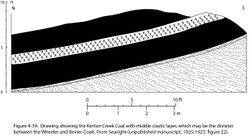Kerton Creek coal bed
The Kerton Creek coal is demoted from a formal member to an informal name and is considered to be the Survant Coal Member.
Lithostratigraphy: Carbondale Formation >>Kerton Creek coal bed
Chronostratigraphy: Paleozoic Erathem >>Pennsylvanian Subsystem >>Desmoinesian Series
Allostratigraphy: Absaroka Sequence
Primary source
Nelson, W.J., P.H. Heckel and J.M. Obrad, 2022, Pennsylvanian Subsystem in Illinois: Illinois State Geological Survey, Bulletin (in press).
Contributing author(s)
W.J. Nelson
Name
Original description
In an unpublished manuscript, Searight (1925–1927) described the “Kerton Creek beds” in southern Fulton County, Illinois. First to mention the Kerton Creek coal in print was Ekblaw (1931), who presented no details. Wanless (1957) made the first detailed description of the Kerton Creek Coal; Kosanke et al. (1960) formalized the unit as a member.
Derivation
The name refers to the stream along which most of the exposures were found.
Other names
None.
Type section
Type location
The type section consists of road cuts, stream banks, and mine openings near the center of the NE¼ sec. 15, T 3 N, R 2 E, Fulton County, on the Astoria 7.5' quadrangle.
Type author(s)
Wanless (1957, geologic section 1, p. 189).
Type status
Unknown.
Reference section
None.
Stratigraphic relationships

Like the Cardiff coal bed and the Roodhouse coal bed, the Kerton Creek is a highly localized deposit confined to channels. As Wanless (1957, p. 98) wrote, “Not even a coaly streak is found to mark its position outside the limited areas where it is present, all of which are in areas of channel deposits of the Pleasantview Sandstone” (Figure 4-38). Wherever the Kerton Creek is present, the overlying Houchin Creek Coal occupies a “stacked” trough and thickens from its normal ≤0.5 ft (15 cm) to 4 ft (120 cm) or more. Smith and Berggren (1963) identified several localities in Fulton and Knox County where this relationship exists. Thus, like Wanless (1952), I interpret the Kerton Creek coal to be Survant Coal that developed as peat in abandoned channel(s). Being redundant, the name “Kerton Creek Coal Member” is dropped from formal usage, although “Kerton Creek coal bed” may be used informally with reference to the type area. The presence of a middle clastic layer at some localities (Figure 4-39) suggests that both Wheeler and Bevier coals may be present.
Extent and thickness
Kerton Creek coal has been reported at several localities in Fulton County, Illinois, and it may occur in Knox County (Wanless 1957; Smith and Berggren 1963). All these deposits are highly localized. The coal dips into troughs 10 to 20 ft (3 to 6 m) deep and attains a maximum thickness of about 5 ft (1.5 m). Not enough information is at hand to determine channel trends or dimensions.
Lithology
The coal is commonly shaly and locally “canneloid.” At the type locality, a claystone layer about 1 ft (0.3 m) thick is near the middle of the seam (Figure 4-39). Wanless (1957) stated that the Kerton Creek has no underclay and is overlain by either “gray shale containing plant leaves” or by “black sheety shale with a limited marine fauna.”
Core(s)
Photograph(s)
Contacts
Little information has been published, but two sections in Wanless (1957) suggest sharp lower and upper contacts.
Well log characteristics
No geophysical log showing the Kerton Creek coal is known.
Fossils
As mentioned above, shale overlying the Kerton Creek contains fossil leaves and an unspecified sparse marine fauna.
Age and correlation
The Kerton Creek coal is herein interpreted to be the Survant Coal Member. It may include either the Wheeler and Bevier Coal Beds, or both.
Environments of deposition
The Kerton Creek originated as peat that filled abandoned channels in the late stage of valley filling. Subsequent compaction of this peat maintained the trough that was filled with overthickened Houchin Creek peat.
Economic importance
Mines that worked this deposit were small, local affairs. The extent of the deposit is unknown but is probably small.
Remarks
References
- Ekblaw, S.E., 1931, Channel deposits of the Pleasantview Sandstone in western Illinois: Illinois State Academy of Science Transactions, v. 23, p. 391–399.
- Kosanke, R.M., J.A. Simon, H.R. Wanless, and H.B. Willman, 1960, Classification of the Pennsylvanian strata of Illinois: Illinois State Geological Survey, Report of Investigations 214, 84 p. and 1 pl.
- Searight, W.V., 1925–1927, Geology and mineral resources of Beardstown Quadrangle: Illinois State Geological Survey, unpublished manuscript, 282 p. plus illustrations.
- Smith, W.H., and D.J. Berggren, 1963, Strippable coal reserves of Illinois, Part 5A, Fulton, Henry, Knox, Peoria, Stark, Tazewell, and parts of Bureau, Marshall, Mercer, and Warren Counties: Illinois State Geological Survey, Circular 348, 59 p., 4 pls.
- Wanless, H.R., 1952, Studies of field relations of coal beds, in Second conference on the origin and constitution of coal, June 18–20, 1952, Crystal Cliffs, Nova Scotia: Nova Scotia Department of Mines, p. 148–180.
- Wanless, H.R., 1957, Geology and mineral resources of the Beardstown, Glasford, Havana, and Vermont Quadrangles: Illinois State Geological Survey, Bulletin 82, 233 p.
ISGS Codes
| Stratigraphic Code | Geo Unit Designation |
|---|---|
